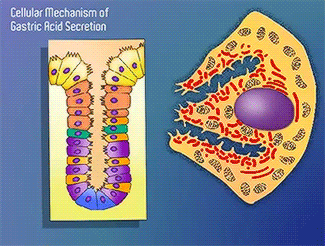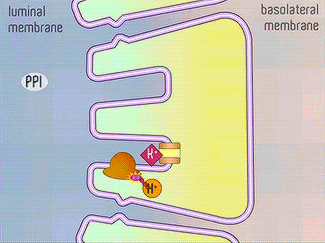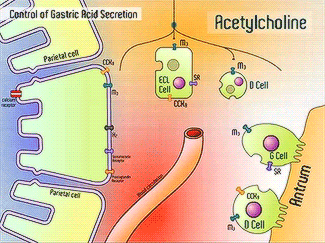Esomeprazole and H+/K+ - ATPase Interaction
From Proteopedia
Introduction. Esomeprazole is the (S) enantiomer of Omeprazole. Esomperazole is a Proton Pump Inhibitor (PPI) that binds to H+/K+-ATPase and inhibits the secretion of gastric acid from parietal cells into the lumen of the stomach. Esomeprazole’s commercial brand name, Nexium, is used to treat Gastro-esophageal Reflux Disease (GERD), peptic and gastric ulcers, and Zollinger-Ellison syndrome [1]. Ulcers caused by the bacterium Helicobacter pylori can be treated using Esomeprazole in conjunction with proper antibiotics [1]. Gastric acid is released through the H+/K+-ATPase pump, which is the final step in acid release [2]. Esomeprazole is a specific, irreversible inhibitor of the pump [2]. H+/K+-ATPaseThe H+/K+-ATPase pump is part of the P-type ATPase family located within the cytoplasmic membrane of resting parietal cells; powered through ATP hydrolysis, the ATPase is translocated to the canalicular membrane and begins to pump cytoplasmic H+ into the canalicular space, in exchange for extracellular K+ ions. H+/K+-ATPase is an α,β-heterodimeric enzyme, where the catalytic site is present in the α subunit [7]. Transmembrane segments TM4, TM5, TM6, and TM8, are located in the α subunit and contain the ion binding region of the enzyme [7]. Binding of ions and ATP to these domains will induce movements in the membrane domain that catalyze ion displacement [7]. Targeting this enzyme using PPIs is the most effective therapeutic control agent of gastric acid secretion [8].
Conformational Change and Signaling Pathway of H+/K+-ATPaseInorganic phosphate produced from the hydrolysis of ATP drives a conformational change in the enzyme and allows release of H+ into the highly acidic environment [11]. The enzyme catalyzes this reaction by changing conformation states between E1 and E2 [12]. ![Conformational Change. The reaction begins when a hydronium ion binds to the enzyme on the cytoplasmic surface [12]. MgATP will phosphorylate the enzyme at an Asp386 residue in a DKTG amino acid sequence to form the E1~Pi H+ intermediate [12]. E1 undergoes a conformational change to form E2, where the ion site is exposed and H+ is released at a pH ~ 1.0 [7]. Extracellular K+ ions then bind to the same exposed region and the enzyme dephosphorylates [7]. An occluded form of the enzyme (trapped) is formed once K+ ions bind; the enzyme de-occludes, reforms the E1 complex, and K+ is released [7].](/wiki/images/thumb/4/4e/E1_to_e2.gif/300px-E1_to_e2.gif) Conformational Change. The reaction begins when a hydronium ion binds to the enzyme on the cytoplasmic surface [12]. MgATP will phosphorylate the enzyme at an Asp386 residue in a DKTG amino acid sequence to form the E1~Pi H+ intermediate [12]. E1 undergoes a conformational change to form E2, where the ion site is exposed and H+ is released at a pH ~ 1.0 [7]. Extracellular K+ ions then bind to the same exposed region and the enzyme dephosphorylates [7]. An occluded form of the enzyme (trapped) is formed once K+ ions bind; the enzyme de-occludes, reforms the E1 complex, and K+ is released [7]. H+/K+-ATPase pumps are normally inactive and inside vesicles [13]. These vesicles are activated through a signaling pathway.
H+/K+-ATPase signal pathway (acetylcholine, histamine, and gastrin) activates the pump in order to move the vesicles toward the lumen [13]. These signals bind to their corresponding receptors and activate the cAMP and Ca2+ dependent pathways [13]. Increased levels of intracellular Ca2+ and cAMP will promote the translocation of vesicles to the canalicular membrane, activating the H+/K+-ATPase [13]. Histamine binds to Histamine H2 and catalyzes the conversion of ATP to cAMP [13].Gastrin will stimulate the release of histamine by binding to CCK2 [13]. Acetylcholine binds to Muscarinic M3 and releases Ca2+ from the endoplasmic reticulum [13].
Esomeprazole MechanismEsomeprazole is protonated twice within the acidic environment, and forms the active inhibitor—achiral sulfenamide at pKa of 1.0 [15].![Activation of Esomeprazole to sulfonamide [7]. R1=OCH3, R2=CH3, R3=CH3, R4=CH3, X=CH, Bz=benzimidazole, Py=pyridine[7]. Mechanism: (1) protonation of Py, (2) protonation of Bz, (3) intramolecular rearrangement of BzH+-Py, forms sulfenic acid (4) dehydration to form sulfenamide (5) disulfide bond formation between enzyme Cys residues and sulfonamide [7].](/wiki/images/thumb/1/10/Mechanism_of_inhibition.jpg/500px-Mechanism_of_inhibition.jpg) Activation of Esomeprazole to sulfonamide [7]. R1=OCH3, R2=CH3, R3=CH3, R4=CH3, X=CH, Bz=benzimidazole, Py=pyridine[7]. Mechanism: (1) protonation of Py, (2) protonation of Bz, (3) intramolecular rearrangement of BzH+-Py, forms sulfenic acid (4) dehydration to form sulfenamide (5) disulfide bond formation between enzyme Cys residues and sulfonamide [7]. Drug-Molecule InteractionThe interaction between Esomeprazole and H+/K+-ATPase has not yet been crystallized [18]. Data obtained from the crystallized structure of a SCH28080-ATPase provides structural and binding site information [19]. SCH28080 is a competitive K+ inhibitor that interacts with the enzyme’s Phe126 residue and prevents disulfide bond formation between Omeprazole and Cys813, suggesting mutually exclusive inhibitions and an overlapping binding site [19]. The crystallized structure of SCH28080-ATPase shows the same luminal-open (E2) conformation as Esomeprazole, and is the first and only crystallized evidence of PPI-ATPase binding site and conformational change [19]. Using this information, the SCH28080-ATPase crystallized structure provides evidence of the two binding sites, Cys813 and Cys892 [18,19]. Cys 813 and Cys 892 residues are within the . Here are the at the binding pocket of Esomeprazole. Glu936 (green), Glu820 (green), Lys791 (deep red), Glu 795 (green), Phe126 (pink), Cys892 (dark blue), and Cys813 (dark blue) are proposed to be part of Esomeprazole’s binding cavity [18,19]. Esomeprazole ResistanceResistance to treatment with PPIs, including Esomeprazole, has been speculated among Barrett’s Esophagus (BE) patients who did not indicate any symptomatic improvement after being placed on a standard PPI drug dose [20]. No contributory mutations causing PPI resistance have been found [20]. It is speculated that the high acid exposure in BE patients may be due to “reflux diathesis” rather than resistance to gastric acid secretion [21]. Other possible reasons for PPI failure include Helicobacter pylori infection, rapid metabolism, and bioavailability; reasons of clinical significance include delayed gastric emptying and visceral hypersensitivity [20]. More studies need to be conducted to understand the mechanisms underlying the development of resistance to PPIs [20]. AcknowledgementsThank you to Dr. David Goode of Mercer University, Department of Chemistry, for his guidance and support in the culmination of this webpage. Notes & References1. Mayo Clinic. Esomeprazole (Oral Route). http//www.mayoclinic.com/health/drug-information/DR603283 (accessed November 11, 2013). 2. National Institutes of Health: DailyMed. NEXIUM (Esomeprazole magnesium) capsule, delayed release [A-S Medication Solutions LLC]. http//dailymed.nlm.nih.gov/dailymed/lookup.cfm?setid=9af7a792-d38a-4b2a-b5d6-855d2183b029 (accessed November 11, 2013). 3. Drug Information Online. Esomeprazole. http//www.drugs.com/ingredient/esomeprazole.html (December 4, 2013). 4. Sachs, G.; and Shin, J.M. Pharmacology of Proton Pump Inhibitors. Curr. Gastroenterol Rep. 2008, 10(6), 528-534. 5. Abcam Biochemicals. Esomeprazole sodium (ab120500). http//www.abcam.com/Esomeprazole-sodium-ab120500.html (accessed November 21, 2013). 6.Nexium (Esomeprazole). https//www.youtube.com/watch?v=pEKFVBbhABE (accessed December 1, 2013) 7. Shin, J.M.; Munson, K; and Sachs, G. The gastric HK-ATPase: structure, function, and inhibition. Eur. Journ. Physio. 2009, 457 (3), 609-622. 8. Sachs, G.; Shin, J. M.; and Howden, C.W. Review article: the clinical pharmacology of proton pump Inhibitors, Aliment Pharmacol Ther. 2006, 26 (7), 2-8. 9. Acid secretion in stomach. https//www.youtube.com/watch?v=Wgs6d919kl0 (accessed December 1, 2013). 10. MTAP - Gastric Acid Secretion and Medicines used in the Treatment of Peptic Ulcers https//www.youtube.com/watch?v=fuG03VDV0N8 (accessed December 1, 2013). 11. Caplan, M.J.; Dunbar, L.A.; Ion Pumps in Polarized Cells: Sorting and Regulation of the Na+,K+- and H+,K+-ATPases. Journal of Bio. Chem. 2001, (276) 29617-29620. 12. Abe, K; Tani, K; Nishizawa, T; and Fujiyoshi, Y; Inter-subunit interaction of gastric H+,K+-ATPase prevents reverse reaction of the transport cycle. EMBO. 2009, (28) 1637 – 1643. 13. Pharmacogenomics Knowledge for Personalized Medicine (PharmGKB). Proton Pump Inhibitor Pathway, Pharmacodynamics. http//www.pharmgkb.org/pathway/PA152530845#PGG (accessed November 24, 2013). 14. MTAP - Gastric Acid Secretion and Medicines used in the Treatment of Peptic Ulcers https//www.youtube.com/watch?v=fuG03VDV0N8 (accessed December 1, 2013). 15. Kendall, M.J.; Review article: Esomeprazole, the first proton pump inhibitor to be developed as an isomer. Aliment Pharmacol Ther. 2003, 17, 1-4. 16. Sachs, G.; Shin, J.M.; and Cho, Y.M. Chemistry of covalent inhibition of the gastric (H+, K+)-ATPase by proton pump inhibitors. J Am Chem Soc. 2004 126(25), 7800-11. 17. Sachs, G.; Besancont, M.; Shin, T.M.; Mercier,F.; Munson, K.T.; Miller, M.; and Hershey, S.G.; Membrane Topology and Omeprazole Labeling of the Gastric H+, K+- Adenosinetriphosphatase. Biochemistry 1993, 32, 2345-2355. 18. Abe, K.;Tani, K.; and Fujiyoshi, Y. Conformational rearrangement of gastric H(+),K(+)-ATPase induced by an acid suppressant. Nat.Commun. 2011, 2, 155. 19. Yan, D.; Yuan-Dong, H.U.; and Mao-Sheng, C.; A model of 3D structure of H+, K+-ATPase catalytic subunit derived by homology modeling. Acta Pharmacol Sin. 2004, 25(4), 474-479. 20. Fass, R.; Shapiro, M.; Dekel, R.; and Sewell, J.; Systematic review: proton-pump inhibitor failure in gastro-oesophageal reflux disease – where next? Aliment Pharmacol Ther. 2005, 22, 79–94. 21. Spechler, S.J.; Sharma, P.; Traxler, B.; Levine, D.; Falk, G.W. Gastric and esophageal pH in patients with Barrett's esophagus treated with three esomeprazole dosages: a randomized, double-blind, crossover trial. Am J Gastroenterol. 2006, 101(9), 1964-71. Proteopedia Page Contributors and EditorsPamiz Alibhai Alisha Arora Deepa Patel Mercer University, Macon, GA 31207 | ||||||||||||
![2D Structure & Biochemical Parameters of Esomeprazole Esomeprazole has two important pyridine and benzimidazole moieties linked through a methylenesulfinyl group [3]. pKa, IC50, AUC, Cmax, and half life values of Esomeprazole [4,5].](/wiki/images/thumb/b/bb/Eso.jpg/300px-Eso.jpg)




